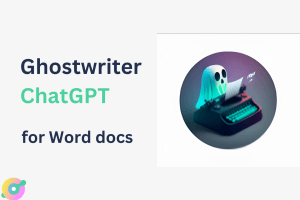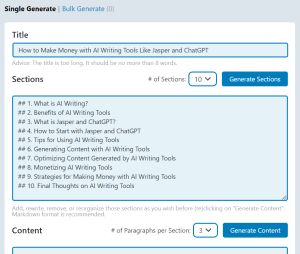Artificial Intelligence (AI) has revolutionized many aspects of our lives, and blogging is no exception.
With the right AI tools, bloggers can streamline their content creation process, enhance their SEO efforts, and produce engaging posts more efficiently.
So, if you are wondering What are the best AI tools for blogging in 2024, then this article explores a curated list of the top AI tools that can help bloggers optimize their writing and manage their blogs with ease.
By leveraging these tools, you can enhance your productivity and ensure your content stands out.
Table of contents
1) KoalaWriter
KoalaWriter is my top pick for blogging in 2024. This AI tool stands out because it’s both powerful and user-friendly. It utilizes the latest GPT-3.5 and GPT-4 technologies to generate high-quality content quickly.
One of the things I love about KoalaWriter is its ability to produce SEO-friendly blog posts with minimal editing required. Whether you’re a solo blogger or run an online business, this tool fits into any workflow effortlessly.
Created by Connor Smith, KoalaWriter has gained significant popularity among content creators. It’s praised for its affordability and effectiveness.
The tool enables me to generate 2,000-word articles within seconds, which is incredibly useful.
KoalaWriter also offers features for proofreading and editing, making it a comprehensive solution for content creation.
This tool has really streamlined my blogging process. You can learn more about it here.
2) GrammarlyGO
GrammarlyGO is a writing assistance tool driven by AI. I find it especially useful for generating text quickly and revising existing content.
With GrammarlyGO, I can brainstorm new ideas or respond to emails more efficiently.
This tool is great for students, writers, marketers, and business professionals. It takes away mundane tasks by automating repetitive writing activities. Using it feels like having a personal editor right at my fingertips.
I access GrammarlyGO through the light bulb icon in the Chrome extension or desktop app. Even as a free user, I get 100 prompts per month. If I need more, I can always upgrade.
One feature I appreciate is its ability to understand the context of my writing. It picks up on the task I need to accomplish, whether it’s replying to an email or drafting a blog post.
This context-based approach helps in generating more relevant and high-quality suggestions. For example, while writing a blog, it suggests ways to improve the text until it meets my satisfaction.
For more details on how GrammarlyGO can enhance your writing experience, check out this guide.
3) Copy.ai
Copy.ai is one of my top picks for AI blogging tools. It’s perfect for bloggers, content creators, social media managers, and email marketers.
This tool helps streamline the content creation process, making it easier to produce quality blog posts.
One feature I love about Copy.ai is its ability to generate content briefs. This saves me a ton of time that I would otherwise spend brainstorming. In just a few clicks, I have a detailed outline ready to go.
Copy.ai also excels at creating SEO-driven content. It can write 50 to 100 unique SEO-optimized pieces each month, which is a huge advantage for anyone looking to improve their search engine rankings.
Using Copy.ai, I can focus on improving the quality of my content rather than worrying about the quantity. The AI does a lot of the heavy lifting when it comes to research and drafting. This makes it easier for me to maintain a consistent posting schedule without feeling overwhelmed.
In terms of ease of use, Copy.ai’s interface is user-friendly. Even if you’re not tech-savvy, you can quickly get the hang of it. This tool simplifies the blogging process, allowing me to focus more on the creative aspects.
4) Jasper
Jasper is an AI writing tool that has gained a lot of attention. It’s designed to help you create long-form content, like blog posts, with ease. I have found it particularly useful for generating high-quality text quickly.
One of Jasper’s standout features is its “Boss Mode.” This feature allows users to have more control and flexibility over the content created. However, it does come at a higher price, which can be a downside for some.
Another feature I appreciate is the no-limits plan. This means users aren’t restricted by usage caps, making it ideal for those who need to produce a lot of content. It’s perfect for writers who want uninterrupted, extensive writing sessions.
Though Jasper is quite powerful, it can be a bit pricey compared to other tools. There are no free plans available, and the entry-level plans are more expensive than some competitors. This might make it less accessible for some users.
For more information, you can check out this Jasper page.
5) Frase
Frase is a powerful AI writing tool designed for creating blog content.
It offers plans that range from $15 to $115 per month, which makes it flexible for both individual bloggers and small teams.
One of the features I find most useful is the ability to support up to three user seats. You can also add more seats at $25 per month each, which is great for growing teams.
Frase helps streamline the content creation process by generating content briefs and optimizing drafts for SEO. This can save a lot of time, especially when working on multiple blog posts per month.
The tool also includes an AI-driven research assistant. This assistant can gather and summarize information, making it easier to create detailed and informative blog posts.
With Frase, I can ensure my content is both high-quality and optimized for search engines. This makes it an invaluable tool for anyone looking to improve their blogging efforts.
Check it out here.
6) Writesonic
Writesonic is a popular tool in the AI writing space. It’s powered by GPT-4, enabling it to create high-quality content.
I find it useful for generating both short-form and long-form content.
One feature I like is its versatility. Writesonic can handle a range of tasks such as blog writing, copywriting, and even paraphrasing. It’s great for various writing needs.
Another thing I appreciate is the templates. Writesonic offers templates for different types of content, making the writing process faster. If I’m stuck, the templates help me get started.
The output quality is impressive. It’s not just about generating text but making sure the text is engaging and well-written. This is crucial for blog posts and marketing materials.
Writesonic also integrates well with other tools. This makes it easier to streamline my workflow. It’s always beneficial when a tool works smoothly with others I use daily.
The pricing is another aspect worth mentioning. Writesonic is affordable, making it accessible even for those on a budget. For anyone looking to enhance their blogging game, it’s a solid choice.
7) Surfer SEO
SurferSEO is a powerful tool for optimizing blog content. I find it incredibly useful for keyword research and improving search engine rankings.
One thing that stands out to me is its ability to create SEO content briefs. This helps me structure my posts in a way that aligns with best SEO practices.
I can also generate articles using SurferSEO’s AI. By entering a keyword and selecting a target location, I get well-written paragraphs or full articles quickly. It’s very efficient.
SurferSEO also helps in editing and auditing existing content. I use it to enhance my older posts, which helps keep my blog fresh and up-to-date.
This tool offers various plans, fitting different needs and budgets. If you’re serious about SEO, SurferSEO is worth considering.
8) INK Editor
INK Editor is an AI writing tool that helps me create high-quality content.
One of the features that really stands out is its ability to optimize content for search engines. This makes it easier for my blog posts to rank higher in search results.
Using INK Editor, I can also benefit from its grammar and style suggestions. It points out errors and offers improvements, which helps me maintain a professional tone in my writing.
Another great aspect of INK Editor is its distraction-free writing environment. The interface is clean and easy to navigate, allowing me to focus on crafting my content without unnecessary distractions.
Additionally, INK Editor offers a WordPress integration. This allows me to publish directly to my blog, simplifying the process of sharing my work online.
For anyone looking to enhance their blog writing, INK Editor is definitely worth considering. It combines SEO optimization, grammar checks, and a user-friendly interface that makes writing and publishing a breeze.
9) MarketMuse
MarketMuse is an AI-driven tool that focuses on content optimization and strategy. I find it particularly useful for improving the relevance and quality of my blog posts.
It goes beyond basic SEO tools by offering insights into user intent and related topics.
I like how MarketMuse analyzes existing content and provides suggestions to enhance it. This includes keyword recommendations and topic ideas that fit naturally into my articles. It helps me better understand what my audience is looking for.
The platform’s content briefs are also a standout feature. They offer a detailed outline of what should be covered in an article, making the writing process smoother. This saves me a lot of time and effort.
MarketMuse also excels in competitive analysis. It allows me to see where my content stands compared to others in my niche. I can identify gaps and opportunities to improve my blog’s reach and effectiveness.
Using MarketMuse has made a noticeable difference in my blogging efforts. Its data-driven approach ensures that my content is both SEO-friendly and valuable to readers.
AI-powered content creation
AI tools for blogging engage directly with enhancing writing efficiency and automating content editing.
These advancements make the content creation process quicker and more accurate without compromising on quality.
Enhancing writing efficiency
AI-powered tools like ChatGPT and Jasper help streamline writing tasks. They can generate blog post ideas, outline structures, and even draft entire articles.
This allows me to focus on refining and personalizing the content rather than starting from scratch.
Features like tone of voice customization and topic suggestions tailor content according to specific audience needs. When I use these tools, I save significant time that can be used for deeper research or more creative endeavors.
Additionally, AI can handle repetitive tasks, reducing the risk of burnout and keeping my writing fresh and engaging.
Automating content editing
Automated content editing tools like Frase.io offer much more than just grammar checks. They provide insights into readability, keyword optimization, and overall structure.
Tools such as these help ensure my writing aligns with SEO best practices, making it more likely to rank higher in search engine results.
Beyond technical aspects, AI can also suggest improvements in style and clarity, enhancing the overall quality of my work. By offering targeted suggestions, these tools help polish my writing, making it more effective and professional.
Leveraging AI for editing streamlines the revision process, ensuring that my content is both error-free and compelling.
SEO optimization with AI
Using AI for SEO optimization can help you improve keyword analysis and personalize your content, driving more organic traffic to your blog.
Keyword analysis
Keyword analysis with AI tools helps you understand which keywords will drive traffic to your blog. Tools like Scalenut offer keyword planners that analyze search volume and relevance.
This means I don’t have to guess which keywords to use.
Another great tool is Frase. It provides optimization suggestions by analyzing the current search engine results page (SERP). It even helps me revise and enhance my own copy, ensuring that my content stays relevant and up-to-date.
Using these AI tools simplifies the process of finding high-performing keywords. This leads to better-targeted content that resonates with the audience, helping my blog rank higher in search results.
Content personalization
AI tools make content personalization easier and more effective.
For instance, WordLift uses an AI-enabled custom knowledge graph tool. This tool helps generate structured data and adds text to meta descriptions, making my content more appealing to search engines.
Another useful tool is RankIQ. It suggests titles and content for blog posts, speeding up the writing process. It also helps me create optimized content that matches what my readers are looking for.
With these AI tools, I can create content that not only ranks well but also engages readers. This boosts my blog’s visibility and ensures that my audience keeps coming back for more.












